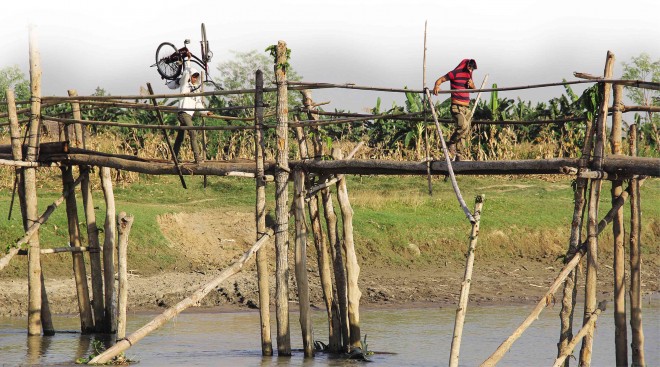
A MAN carries his bike across the bridge in the village of Tukanalipao in Mamasapano town, Maguindanao province. BARRY OHAYLAN/CONTRIBUTOR
TUKANALIPAO, Mamasapano—The wooden bridge here, located some 3 kilometers from the concrete highway, spells bad memories of the events of Jan. 25.
It was here that 64 people—44 elite police troopers, 17 Moro Islamic Liberation Front (MILF) separatist rebels and three civilians—were killed in what has become a stain on the 17-year peace negotiations with the Moro insurgents.
On Tuesday, government and MILF leaders said they wanted to erase the bridge’s image as “the bridge of no return” to “the bridge of peace.”
More projects to come
The groundbreaking ceremony was held that day for the conversion of the bridge from a wooden structure into a sturdier one and for the construction of other projects here. It was attended by Budget Secretary Florencio Abad, Armed Forces Chief Gen. Gregorio Catapang Jr., Autonomous Region in Muslim Mindanao Gov. Mujiv Hataman and MILF spokesperson Von Al Haq.
“These are not just the first projects that will improve your community. There will be more to come here in order to address hardship, which breeds conflict,” said Abad, who had flown with Catapang from Manila and traveled from the Awang Airport near Cotabato City under heavy security escort to this village—considered “ground zero” of the infamous “encounter,” which a Senate investigation and report described as a “massacre.”
“This is to help prove to you that national government will come here,” Abad said.
He said development and peace can be maintained in the area if poverty is addressed.
According to Abad, the Department of Public Works and Highways will construct a P10-million 120-meter steel footbridge in place of the wooden bridge and will also start construction of a P7.5-million 820-meter access road from the main highway.
Building peace
Hataman said some P10 million will also be poured in for livelihood projects and the rehabilitation of the village’s schools.
“To build peace is a lengthy process. One requirement of creating peace is to achieve stability in all aspects, which include political, social and total development in the area,” Al Haq commented.
Catapang said he had to see for himself the construction of the bridge because it highlights the military’s pursuit of peace in the region.
“This might be one of the most important places I’ve visited,” he said, adding that he witnessed how difficult it had been for villagers to live in a period of no peace.
Rebuilding can start
“I was once involved in an all-out-offensive and I nearly got killed,” said Catapang, recalling his days as a young lieutenant in Palimbang, Sultan Kudarat.
Brig. Gen. Joselito Kakilala, AFP spokesperson and Civil Relations Service commander, earlier said that now that the Bangsamoro Islamic Freedom Fighters had been driven out of town, the government can now focus on rebuilding the affected communities.
“We will help the LGUs (local government units), other government agencies and the national government as a whole in delivering public services to the people. We will support the implementation of development projects that are intended to spur economic activities in these areas,” Kakilala said in a statement.
He said President Aquino had initially approved the release of P67 million to fund “various socioeconomic interventions for the people of Maguindanao,” including the Bridge of Peace here, Schools for Peace and Roads for Peace.
“We are calling on everyone to help the people in the affected communities to go back to their normal lives and support their pursuit of lasting peace,” Catapang said.
RELATED STORIES
Death bridge also symbol of neglect
Peace bridge over Mamasapano river